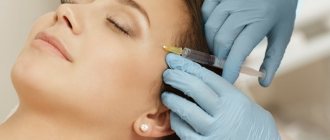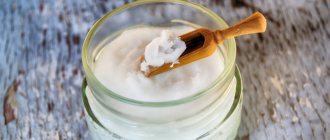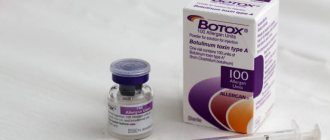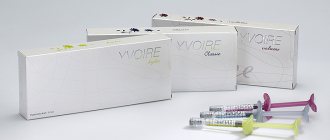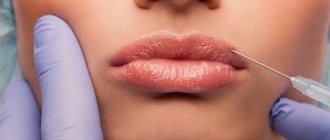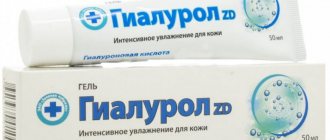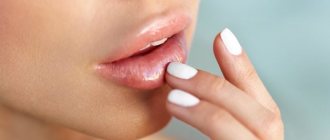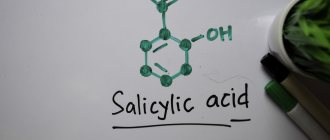N. P. Mikhailova, dermatologist, cosmetologist, member of the American Academy of Dermatologists (AAD), certified trainer (France), chief physician of the Reforma clinic, Moscow
I. V. Kochurova, dermatologist, cosmetologist, oncologist, methodologist in the direction of “Contour plastic surgery and mesotherapy”, Martinex Medical Center, Moscow
V. V. Bazarny Doctor of Medical Sciences, Professor of the Department of Clinical Laboratory Diagnostics and Bacteriology, Chief Researcher of the Central Research Laboratory of the Ural State Medical Academy, Yekaterinburg
Relevance of the problem
The skin is one of the largest human organs. It is in direct contact with the external environment and constantly experiences antigenic load, acting as an organ of immunogenesis [5]. This is proven, in particular, by the fact that the dermis contains immunocompetent cells and mediators of both natural and adaptive immunity [6, 15, 17]. It is no coincidence that in recent decades the idea of the skin immune system—SALT—has been formed, which is the subject of a number of modern reviews [1, 5, 6, 15, 16].
Disorders of the skin immune system underlie the immunopathogenesis of some diseases - psoriasis, atopic dermatitis, acne, skin lymphomas and others [13, 14, 16, 20, 49]. Therefore, the study of immunological mechanisms of regulation of skin functions in normal and pathological conditions, as well as the correction of immunopathological mechanisms in skin diseases and optimization of restoration processes in it remain an urgent scientific and clinical task. To solve this problem, a number of immunomodulators have been proposed: levamisole, cytomedins, cytokines, Gepon, recombinant interferons (Reaferon, Intron-A) [9, 10]. However, their effectiveness is not always high, and the results of their use are sometimes contradictory and ambiguous. There are also side effects. To reduce systemic complications of immunomodulatory therapy, local intradermal administration of immunomodulators seems promising. In particular, in the studies of Bazarny et al. [2] it has been shown that intradermal injections of Ribomunil not only have an immunotropic effect, but also activate reparative processes in the skin. However, there is virtually no other evidence of the effectiveness of immunomodulators when used intradermally.
In this regard, the immunological role of hyaluronic acid - as the main component of the intercellular matrix of the skin - in the regulation of inflammation, regeneration, in ensuring immunological tolerance and immunomodulation is interesting.
Facts and statistics
- Allergies are classified as chronic diseases. In terms of prevalence, it is in “honorable” fifth place.
- According to research results, up to 40% of Russians have already encountered at least once manifestations of a “rebellion” of the immune system.
- The probability that a child of healthy parents will be allergic is about 15%, if the disease existed in the family, then the chances increase to 50%, but if the parents directly experience manifestations of a specific reaction, then allergists are confident that in 80% of cases the disease will be transmitted through inheritance.
- Doctors estimate that 90% of the population has a predisposition to allergies. This means that the reaction can occur at any time if several provoking factors coincide.
Development of ideas about the role of hyaluronic acid in the body and skin
Over the past two decades, significant progress has been made in understanding the role of hyaluronic acid (HA) in the regulation of both physiological and pathological conditions, and the mechanisms of its synthesis and degradation have been determined. Currently, numerous scientific studies are being conducted on the role of GC in angiogenesis, in the development of malignant neoplasms, diseases of the joints, lungs and skin, and the participation of GC in the immune regulation of various physiological and pathological conditions is being studied.
Hyaluronic acid is a non-sulfated glycosaminoglycan, an unbranched polysaccharide consisting of disaccharide units formed by N-acetyl-D-glucosamine and D-glucuronic acid, which are interconnected by b-1,3- and b-1,4-glycosidic bonds (Fig. 1).
In humans, HA is found in various tissues in the form of sodium salt (sodium hyaluronate), being one of the main components of the extracellular matrix (ECM), the vitreous body of the eye and synovial fluid. The presence of hyaluronic acid in the skin was first demonstrated by Meyer in 1948 [39]. Since the discovery of HA in 1934, there has been a transition from the original point of view, according to which HA was considered a passive structural component of the ECM, providing, in particular, impermeability skin for microbes and toxins, to the recognition that this widespread macromolecule is dynamically involved in many biological processes - from modulation of cell migration and differentiation during embryogenesis to regulation of ECM metabolism and important roles in wound healing, inflammation and metastasis [8, 22]. Due to its properties, HA is used in clinical practice. It is part of preparations with disinfectant, anti-inflammatory and wound-healing effects. At the same time, HA is involved in the processes of growth and regeneration, reduces the permeability of barrier tissues, and prevents the formation of granulation tissue and scars.
Myth 4. Hyaluronic acid is only used to plump lips and fill wrinkles.
This is wrong. Treatment with hyaluronic acid is one of the most popular areas in aesthetic medicine.
Examples of procedures:
- oval face modeling;
- non-surgical nose correction;
- mesotherapy;
- treatment of symptoms of vaginal aging, in particular with excessive dryness of the mucous membrane;
- enlargement of the labia in intimate plastic surgery;
- injection reshaping of the clitoris;
- rejuvenation of different parts of the body;
- treatment of some forms of urinary incontinence, etc.
Hyaluronic acid injection
Hyaluron-binding proteins
In addition to molecular weight, the manifestation of the immunotropic effects of HA is influenced by the level of expression of HA receptors (hyaluronan-binding proteins) on the membranes of various immunocompetent cells, fibroblasts, keratinocytes, and endothelial cells.
Most of the HA exists in the intercellular matrix in free soluble form. Another part of HA is covalently bound to various proteins [48]. Hyaluronan-binding proteins, or hyaladherins, can be divided into several types:
- Proteins that bind HA to other extracellular matrix molecules, such as aggrecan and versican. By binding to them, HA forms the structure of different types of connective tissue.
- Proteins that act as cellular GC receptors, such as CD44, RHAMM, TNFIP6, SHAP, LYVE-1 and others.
Thus, the manifestation of the immunotropic effects of HA depends not only on its molecular weight, but also on the level of expression of hyaluronan-binding proteins and the function of immunocompetent cells. Taking into account the important role of hyaluronan-binding proteins in the manifestation of the unique immunological properties of HA, it is possible to develop a new strategy for immunomodulation and immunocorrection of chronic dermatoses, prevention and treatment of photo- and chronoaging of the skin, which will be based on the use of HA preparations of various molecular weights and combination preparations based on it.
Myth 7. Hyaluronic acid injections are suitable for everyone
No. Any intervention in the body carries the risk of adverse consequences. Therefore, the specialist performing the procedure will first conduct an examination and consultation. In addition, there are defects that require more serious intervention - in cases where surgery is needed, hyaluronic acid will not help.
Specialist comment: surgeon-gynecologist A.V. Ivanova
Surgeon A. Ivanov warns: “Before using any remedy, incl. and hyaluronic acid, you need to make sure there are no contraindications. The most common contraindications for this substance: pregnancy, lactation, problems with blood clotting. It is also necessary to rule out allergies. You also need to remember that all interventions should be carried out only as prescribed by a doctor.”
To be absolutely sure that the procedure is safe, you should ask a specialist questions, and only then carry out the procedure. Any injections can only be done in special clinics. Beauty salons are not the place to experiment with your body and health.
Immunotropic effects of hyaluronic acid in the skin
In the dermis, HA forms a framework to which other glycosaminoglycans (primarily chondroitin sulfate) and proteins, called hyaladherins for their ability to specifically bind to HA, are attached. In this case, a polymer network is formed, which fills most of the extracellular space, providing mechanical support for tissues, rapid diffusion of water-soluble molecules and cell migration. In the epidermis, HA is localized in the pericellular space, creating an areole that surrounds the cell and protects it from the action of toxic substances [42].
In intact, healthy skin, high molecular weight and low molecular weight fractions of HA are in dynamic equilibrium, which is shifted towards high molecular weight fractions (molecular weight more than 1,000,000 Da), which have good moisture-retaining and anti-inflammatory properties.
With excessive ultraviolet irradiation, bacterial invasion, trauma, chronic diseases, exposure to allergens and other adverse factors, acute or chronic inflammation develops in the skin, as a result of which low molecular weight fractions with pro-inflammatory and immunostimulating properties begin to predominate in the composition of HA.
HA is a unique molecule that takes part in all stages of the development of inflammation in the skin - from alteration to proliferation. During alteration, under the influence of reactive oxygen species produced by neutrophils and tissue and bacterial hyaluronidases, degradation of high molecular weight fractions of HA and other components of the extracellular matrix is observed [38]. A large number of oligosaccharides are formed that interact with the receptors CD44, RHAMM, TLR2 and TLR4 on the surface of macrophages, lymphocytes, and fibroblasts, which ensures their migration to the damaged area. In addition, oligosugars bind to cell adhesion receptors of the vascular endothelium, which promotes the release of leukocytes and lymphocytes circulating in the blood into the inflammation zone. The interaction of low molecular weight fragments of HA with the receptors CD44, RHAMM, TLR2 and TLR4 leads to the activation of intracellular reactions and the synthesis of proinflammatory cytokines by immunocompetent cells, fibroblasts and keratinocytes, which act as mediators of the immune response, regulate the functions of immunocompetent cells, and ensure their interaction in inflammatory reactions. In addition, proinflammatory cytokines further enhance the expression of CD44, RHAMM, TLR2 and TLR4 receptors on the membrane of immunocompetent cells and fibroblasts, to which HA fragments bind. As a result, differentiation and proliferation of these cells occurs, the synthesis of extracellular matrix components and GC increases, and new blood vessels grow. A biological barrier is formed around the source of damage, which limits the area of damage and creates favorable conditions for proliferation and repair [12].
Thus, HA can be called an important regulator of the functions of immune cells in the skin. Low molecular weight fragments act as signaling molecules that signal tissue damage and mobilize immune cells, while high molecular weight forms of HA suppress immune cell functions and prevent excessive exacerbation of inflammation.
How to quickly remove hyaluronic acid from lips?
There is a fairly wide range of techniques to correct the situation. In general, they all solve the same problem - to enhance metabolic processes in the correction area, which ultimately leads to accelerated breakdown and removal of the injected hyaluronic acid from the body.
Microcurrent therapy
The therapeutic effect is exerted by weak pulse currents with a strength of 10 to 600 μA. The procedure is so delicate that it causes virtually no discomfort.
Preparation consists of cleansing the skin, after which the cosmetologist applies a conductive gel to it and begins the effect using an electrode: stationary; movable; conductive gloves.
Electroporation
A hardware method in which cosmetic preparations are introduced into the skin using weak electromagnetic pulses. It is painless and has virtually no side effects.
Vaporization
Vaporization is a deep cleansing of the face with special steam. This manipulation increases blood circulation, due to which accelerated removal of the filler occurs.
Contraindications for this procedure include hypertension and respiratory diseases.
Massage and compresses
Affordable, safe, pleasant procedures. But they must be carried out by an experienced doctor, since excess filler stretches the skin and, if the manipulations are carried out incorrectly, this effect will intensify.
Hyaluronidase injections
Hyaluronidase refers to enzymes, that is, protein substances that accelerate the occurrence of chemical reactions in cells. Under its influence, hyaluronic acid, which was introduced as a filler, breaks down into its component parts (oligomers) and is quickly removed from the tissues.
Using hyaluronidase injections, you can remove both fresh filler and the one that was injected several months ago.
It is interesting to note that hyaluronidase can only remove hyaluronic acid and cannot be used to remove collagen, silicone or hydroxypropionic acid. The effect of the drug begins immediately after its administration. Sometimes, if a large amount of hyaluronic acid needs to be removed, several injections of hyaluronodase may be required. In most cases, within 1-2 days (sometimes within 7 days) the hyaluronic acid will be completely removed.
Hyaluronodase should only be administered by an experienced specialist. Some conditions may be contraindications for the procedure.
The introduction of hyaluronodase has some nuances. For example, if a patient wishes to correct newly acquired volume, the injection of hyaluronidase will cause the gel to dissolve unevenly and the lips to appear asymmetrical. As for side effects and allergic reactions, they can occur with absolutely any drug.
Why do late complications of GC occur?
It seems surprising that problems arise months later, since by this time the acid should have partially, if not completely, dissolved. This is the paradox: the complication becomes obvious precisely after partial metabolization of the drug. This is because the acid previously masked the problem.
Late complications are associated with the chemical composition of the drug used to purify and cross-link the hyaluronic acid. While there is a lot of acid, these chemicals are hidden, and when the acid is depleted, chemical additives make themselves felt.
The biggest danger in such situations is that the doctor does not know exactly what these elements are and how they should be dealt with. Patients, turning to a cosmetologist, often do not even remember or do not know what exactly was injected into them. And even if this is known, after so many months it is impossible to track the quality and composition of the administered drug.
Photo 1. Late complications of GC
Photo 2. Late complications of GC
Photo 3. Late complications of GC
One of the possible complications is severe swelling at the site of GC injection. If the problem is not in the hyaluronic acid itself, after it is dissolved by hyaluronidase, the problem of swelling will not go away. This is because the tissue has been exposed to a foreign chemical that the life-saving hyaluronidase cannot target.
This problem concerns poorly purified acids. And we are not talking about removing the cell walls of bacteria, but about adding or retaining harmful chemical compounds used to “improve” the drug.
After biorevitalization: prohibitions and restrictions
- Any injection procedure is accompanied by a violation of the integrity of the skin. The barrier function of the epidermis, albeit to a small extent, weakens. The risk of infection increases, and therefore after biorevitalization of the face you should touch the correction area with your hands as little as possible. A simple measure will help avoid infectious and inflammatory reactions.
- The face after biorevitalization should not be exposed to ultraviolet radiation. You should avoid visiting the solarium and do not sunbathe on the beach. If you are undergoing a rejuvenation course in the summer, try to spend as little time as possible in the open sun.
- Facial care after biorevitalization should be as gentle and gentle as possible. Decorative cosmetics can close the ducts of the sebaceous and sweat glands (pores), which will lead to undesirable consequences. You cannot use the “decorative” for 7 days after the session. It is also undesirable to use skincare cosmetics, with the exception of products prescribed by a cosmetologist.
- What you definitely cannot do after a biorevitalization session is drink alcohol. Ethanol is a toxic substance, in other words, poison. Even minimal doses of alcohol have an extremely negative effect on metabolic processes. The elimination of toxins slows down, toxic metabolic products and free radicals accumulate in the tissues. In addition, fluid is retained, which can lead to the formation of edema. The main thing! Alcohol blocks regenerative processes , for the sake of activation of which a course of facial biorevitalization is carried out!
- Injections of hyaluronic acid in a certain percentage of cases lead to the appearance of papules (rashes), redness, and swelling of the skin. Patients try to remove side effects with the help of massage, but this cannot be done.
- After the procedure, you cannot do manual or hardware facial cleansing, mechanical or chemical peels.
- Heavy physical activity is contraindicated after facial biorevitalization. It is necessary to take a break from fitness classes for one week, and household stress should also be avoided.
- After the procedure, you should not expose your body to significant temperature changes. For this reason, solariums, spa treatments, saunas (including cryosaunas) and steam rooms are prohibited. You should not take hot baths at home; contrast showers are contraindicated.

